Machine Learning in Internet of Things (IOT)
VerifiedAdded on 2024/04/25
|8
|2103
|124
AI Summary
This report explores the integration of machine learning in IoT, discussing its applications, algorithms, challenges, and potential. It emphasizes the importance of data analysis and intelligent processing in developing smart IoT applications.
Contribute Materials
Your contribution can guide someone’s learning journey. Share your
documents today.

ITC560 - ASSIGNMENT 3
Secure Best Marks with AI Grader
Need help grading? Try our AI Grader for instant feedback on your assignments.
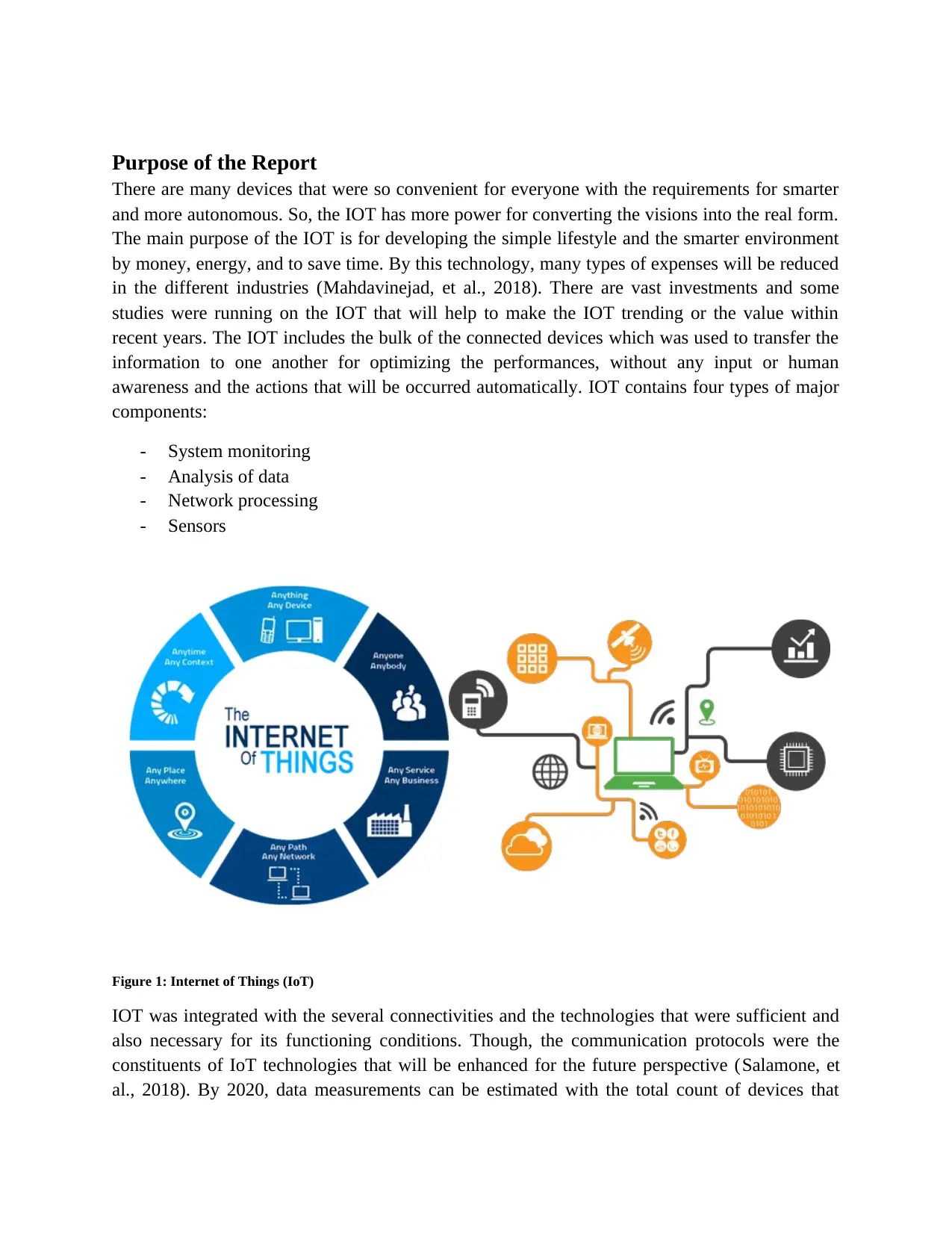
Purpose of the Report
There are many devices that were so convenient for everyone with the requirements for smarter
and more autonomous. So, the IOT has more power for converting the visions into the real form.
The main purpose of the IOT is for developing the simple lifestyle and the smarter environment
by money, energy, and to save time. By this technology, many types of expenses will be reduced
in the different industries (Mahdavinejad, et al., 2018). There are vast investments and some
studies were running on the IOT that will help to make the IOT trending or the value within
recent years. The IOT includes the bulk of the connected devices which was used to transfer the
information to one another for optimizing the performances, without any input or human
awareness and the actions that will be occurred automatically. IOT contains four types of major
components:
- System monitoring
- Analysis of data
- Network processing
- Sensors
Figure 1: Internet of Things (IoT)
IOT was integrated with the several connectivities and the technologies that were sufficient and
also necessary for its functioning conditions. Though, the communication protocols were the
constituents of IoT technologies that will be enhanced for the future perspective (Salamone, et
al., 2018). By 2020, data measurements can be estimated with the total count of devices that
There are many devices that were so convenient for everyone with the requirements for smarter
and more autonomous. So, the IOT has more power for converting the visions into the real form.
The main purpose of the IOT is for developing the simple lifestyle and the smarter environment
by money, energy, and to save time. By this technology, many types of expenses will be reduced
in the different industries (Mahdavinejad, et al., 2018). There are vast investments and some
studies were running on the IOT that will help to make the IOT trending or the value within
recent years. The IOT includes the bulk of the connected devices which was used to transfer the
information to one another for optimizing the performances, without any input or human
awareness and the actions that will be occurred automatically. IOT contains four types of major
components:
- System monitoring
- Analysis of data
- Network processing
- Sensors
Figure 1: Internet of Things (IoT)
IOT was integrated with the several connectivities and the technologies that were sufficient and
also necessary for its functioning conditions. Though, the communication protocols were the
constituents of IoT technologies that will be enhanced for the future perspective (Salamone, et
al., 2018). By 2020, data measurements can be estimated with the total count of devices that
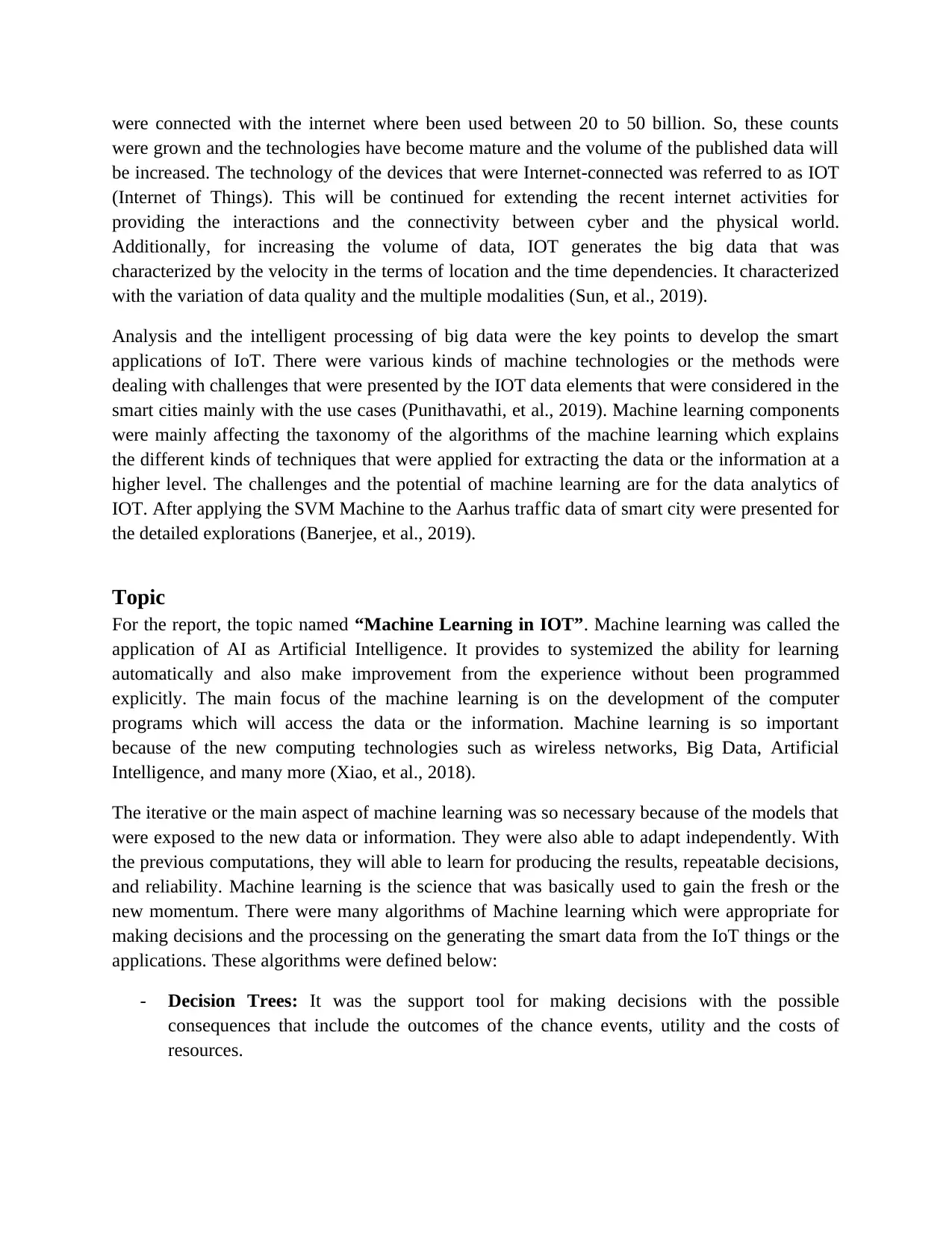
were connected with the internet where been used between 20 to 50 billion. So, these counts
were grown and the technologies have become mature and the volume of the published data will
be increased. The technology of the devices that were Internet-connected was referred to as IOT
(Internet of Things). This will be continued for extending the recent internet activities for
providing the interactions and the connectivity between cyber and the physical world.
Additionally, for increasing the volume of data, IOT generates the big data that was
characterized by the velocity in the terms of location and the time dependencies. It characterized
with the variation of data quality and the multiple modalities (Sun, et al., 2019).
Analysis and the intelligent processing of big data were the key points to develop the smart
applications of IoT. There were various kinds of machine technologies or the methods were
dealing with challenges that were presented by the IOT data elements that were considered in the
smart cities mainly with the use cases (Punithavathi, et al., 2019). Machine learning components
were mainly affecting the taxonomy of the algorithms of the machine learning which explains
the different kinds of techniques that were applied for extracting the data or the information at a
higher level. The challenges and the potential of machine learning are for the data analytics of
IOT. After applying the SVM Machine to the Aarhus traffic data of smart city were presented for
the detailed explorations (Banerjee, et al., 2019).
Topic
For the report, the topic named “Machine Learning in IOT”. Machine learning was called the
application of AI as Artificial Intelligence. It provides to systemized the ability for learning
automatically and also make improvement from the experience without been programmed
explicitly. The main focus of the machine learning is on the development of the computer
programs which will access the data or the information. Machine learning is so important
because of the new computing technologies such as wireless networks, Big Data, Artificial
Intelligence, and many more (Xiao, et al., 2018).
The iterative or the main aspect of machine learning was so necessary because of the models that
were exposed to the new data or information. They were also able to adapt independently. With
the previous computations, they will able to learn for producing the results, repeatable decisions,
and reliability. Machine learning is the science that was basically used to gain the fresh or the
new momentum. There were many algorithms of Machine learning which were appropriate for
making decisions and the processing on the generating the smart data from the IoT things or the
applications. These algorithms were defined below:
- Decision Trees: It was the support tool for making decisions with the possible
consequences that include the outcomes of the chance events, utility and the costs of
resources.
were grown and the technologies have become mature and the volume of the published data will
be increased. The technology of the devices that were Internet-connected was referred to as IOT
(Internet of Things). This will be continued for extending the recent internet activities for
providing the interactions and the connectivity between cyber and the physical world.
Additionally, for increasing the volume of data, IOT generates the big data that was
characterized by the velocity in the terms of location and the time dependencies. It characterized
with the variation of data quality and the multiple modalities (Sun, et al., 2019).
Analysis and the intelligent processing of big data were the key points to develop the smart
applications of IoT. There were various kinds of machine technologies or the methods were
dealing with challenges that were presented by the IOT data elements that were considered in the
smart cities mainly with the use cases (Punithavathi, et al., 2019). Machine learning components
were mainly affecting the taxonomy of the algorithms of the machine learning which explains
the different kinds of techniques that were applied for extracting the data or the information at a
higher level. The challenges and the potential of machine learning are for the data analytics of
IOT. After applying the SVM Machine to the Aarhus traffic data of smart city were presented for
the detailed explorations (Banerjee, et al., 2019).
Topic
For the report, the topic named “Machine Learning in IOT”. Machine learning was called the
application of AI as Artificial Intelligence. It provides to systemized the ability for learning
automatically and also make improvement from the experience without been programmed
explicitly. The main focus of the machine learning is on the development of the computer
programs which will access the data or the information. Machine learning is so important
because of the new computing technologies such as wireless networks, Big Data, Artificial
Intelligence, and many more (Xiao, et al., 2018).
The iterative or the main aspect of machine learning was so necessary because of the models that
were exposed to the new data or information. They were also able to adapt independently. With
the previous computations, they will able to learn for producing the results, repeatable decisions,
and reliability. Machine learning is the science that was basically used to gain the fresh or the
new momentum. There were many algorithms of Machine learning which were appropriate for
making decisions and the processing on the generating the smart data from the IoT things or the
applications. These algorithms were defined below:
- Decision Trees: It was the support tool for making decisions with the possible
consequences that include the outcomes of the chance events, utility and the costs of
resources.
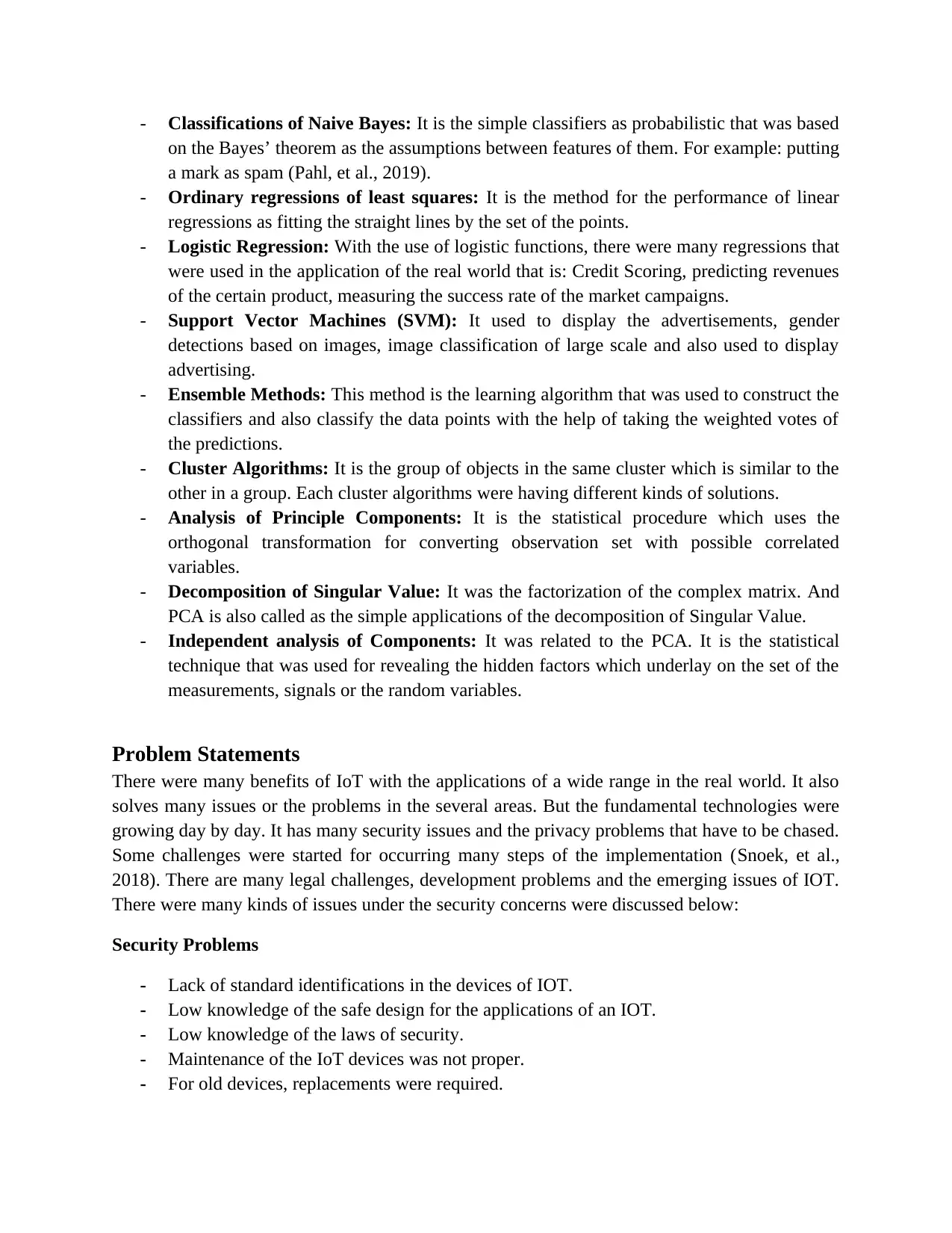
- Classifications of Naive Bayes: It is the simple classifiers as probabilistic that was based
on the Bayes’ theorem as the assumptions between features of them. For example: putting
a mark as spam (Pahl, et al., 2019).
- Ordinary regressions of least squares: It is the method for the performance of linear
regressions as fitting the straight lines by the set of the points.
- Logistic Regression: With the use of logistic functions, there were many regressions that
were used in the application of the real world that is: Credit Scoring, predicting revenues
of the certain product, measuring the success rate of the market campaigns.
- Support Vector Machines (SVM): It used to display the advertisements, gender
detections based on images, image classification of large scale and also used to display
advertising.
- Ensemble Methods: This method is the learning algorithm that was used to construct the
classifiers and also classify the data points with the help of taking the weighted votes of
the predictions.
- Cluster Algorithms: It is the group of objects in the same cluster which is similar to the
other in a group. Each cluster algorithms were having different kinds of solutions.
- Analysis of Principle Components: It is the statistical procedure which uses the
orthogonal transformation for converting observation set with possible correlated
variables.
- Decomposition of Singular Value: It was the factorization of the complex matrix. And
PCA is also called as the simple applications of the decomposition of Singular Value.
- Independent analysis of Components: It was related to the PCA. It is the statistical
technique that was used for revealing the hidden factors which underlay on the set of the
measurements, signals or the random variables.
Problem Statements
There were many benefits of IoT with the applications of a wide range in the real world. It also
solves many issues or the problems in the several areas. But the fundamental technologies were
growing day by day. It has many security issues and the privacy problems that have to be chased.
Some challenges were started for occurring many steps of the implementation (Snoek, et al.,
2018). There are many legal challenges, development problems and the emerging issues of IOT.
There were many kinds of issues under the security concerns were discussed below:
Security Problems
- Lack of standard identifications in the devices of IOT.
- Low knowledge of the safe design for the applications of an IOT.
- Low knowledge of the laws of security.
- Maintenance of the IoT devices was not proper.
- For old devices, replacements were required.
on the Bayes’ theorem as the assumptions between features of them. For example: putting
a mark as spam (Pahl, et al., 2019).
- Ordinary regressions of least squares: It is the method for the performance of linear
regressions as fitting the straight lines by the set of the points.
- Logistic Regression: With the use of logistic functions, there were many regressions that
were used in the application of the real world that is: Credit Scoring, predicting revenues
of the certain product, measuring the success rate of the market campaigns.
- Support Vector Machines (SVM): It used to display the advertisements, gender
detections based on images, image classification of large scale and also used to display
advertising.
- Ensemble Methods: This method is the learning algorithm that was used to construct the
classifiers and also classify the data points with the help of taking the weighted votes of
the predictions.
- Cluster Algorithms: It is the group of objects in the same cluster which is similar to the
other in a group. Each cluster algorithms were having different kinds of solutions.
- Analysis of Principle Components: It is the statistical procedure which uses the
orthogonal transformation for converting observation set with possible correlated
variables.
- Decomposition of Singular Value: It was the factorization of the complex matrix. And
PCA is also called as the simple applications of the decomposition of Singular Value.
- Independent analysis of Components: It was related to the PCA. It is the statistical
technique that was used for revealing the hidden factors which underlay on the set of the
measurements, signals or the random variables.
Problem Statements
There were many benefits of IoT with the applications of a wide range in the real world. It also
solves many issues or the problems in the several areas. But the fundamental technologies were
growing day by day. It has many security issues and the privacy problems that have to be chased.
Some challenges were started for occurring many steps of the implementation (Snoek, et al.,
2018). There are many legal challenges, development problems and the emerging issues of IOT.
There were many kinds of issues under the security concerns were discussed below:
Security Problems
- Lack of standard identifications in the devices of IOT.
- Low knowledge of the safe design for the applications of an IOT.
- Low knowledge of the laws of security.
- Maintenance of the IoT devices was not proper.
- For old devices, replacements were required.
Secure Best Marks with AI Grader
Need help grading? Try our AI Grader for instant feedback on your assignments.

Legal problems
- Require development in the trust and the policies of the law.
- Policies of the development of data sharing.
- Breaching liability problems.
- Use of application information is so discriminatory.
Development Problems
- Increase burden and the pressure on the communication networks.
- Technical evaluation and the benefits of the economic sources were limited.
- The strength of the infrastructure of the internet was limited.
- Lack in the regulation and the policies awareness (Chung, et al., 2017).
Technical Risks and Issues
- Knowledge of the risks of the technical design was not proper.
- Lacking in the documentation.
- No proper management of time and the technology investments.
- Limitations of technology and resources investments.
- Lacking proper implementations of the application as per the standards.
The technology of machine learning was the analysis and the intelligent processing of big data
with the key points for developing the application of an IOT. There are many kinds of machine
technologies which deal with the challenges which were presented by the data elements of IOT.
The challenges and the potential of machine learning are for the data analytics of IOT. After
applying the SVM Machine to the Aarhus traffic data of smart city were presented for the
detailed explorations (Jeong, et al., 2017).
- Require development in the trust and the policies of the law.
- Policies of the development of data sharing.
- Breaching liability problems.
- Use of application information is so discriminatory.
Development Problems
- Increase burden and the pressure on the communication networks.
- Technical evaluation and the benefits of the economic sources were limited.
- The strength of the infrastructure of the internet was limited.
- Lack in the regulation and the policies awareness (Chung, et al., 2017).
Technical Risks and Issues
- Knowledge of the risks of the technical design was not proper.
- Lacking in the documentation.
- No proper management of time and the technology investments.
- Limitations of technology and resources investments.
- Lacking proper implementations of the application as per the standards.
The technology of machine learning was the analysis and the intelligent processing of big data
with the key points for developing the application of an IOT. There are many kinds of machine
technologies which deal with the challenges which were presented by the data elements of IOT.
The challenges and the potential of machine learning are for the data analytics of IOT. After
applying the SVM Machine to the Aarhus traffic data of smart city were presented for the
detailed explorations (Jeong, et al., 2017).
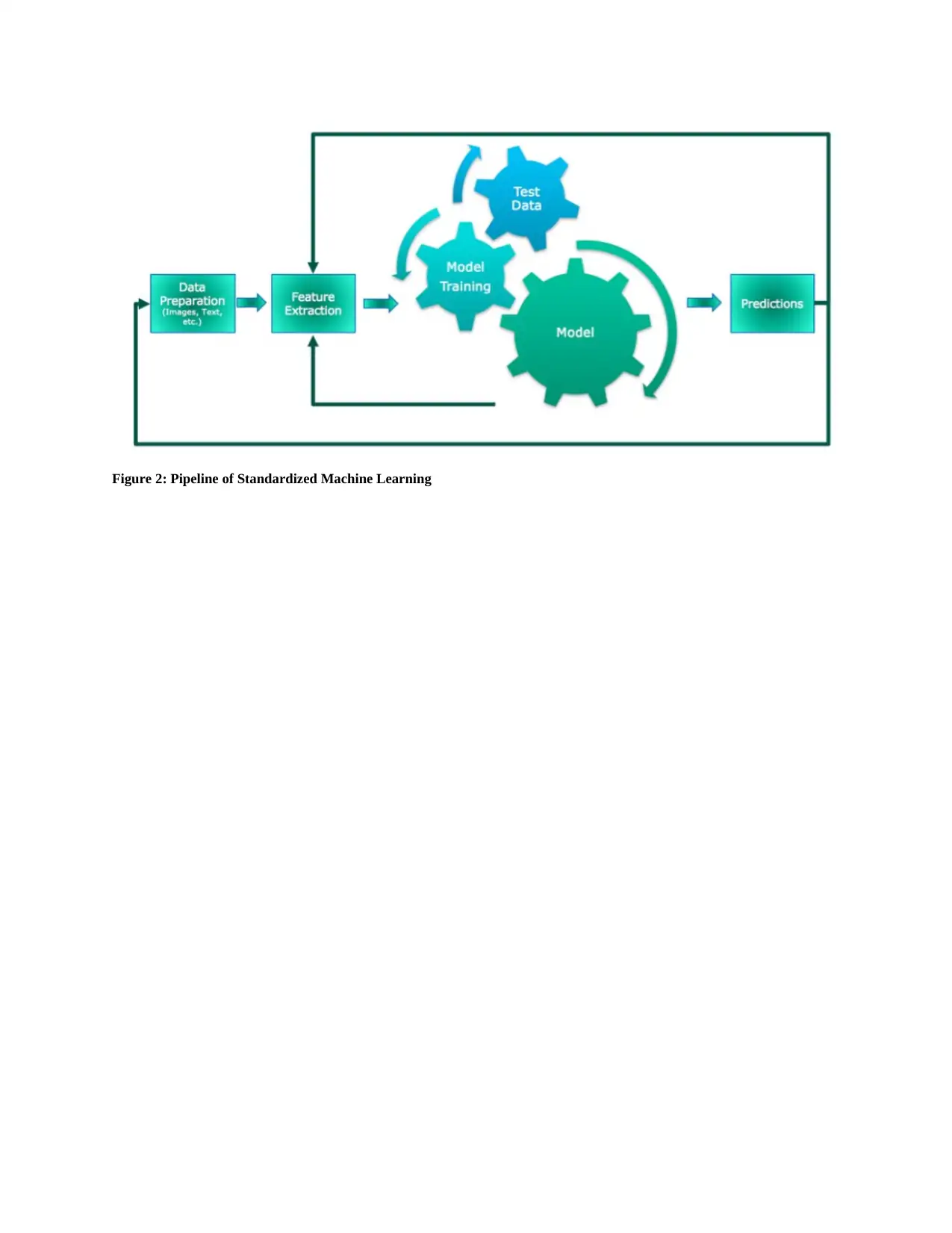
Figure 2: Pipeline of Standardized Machine Learning
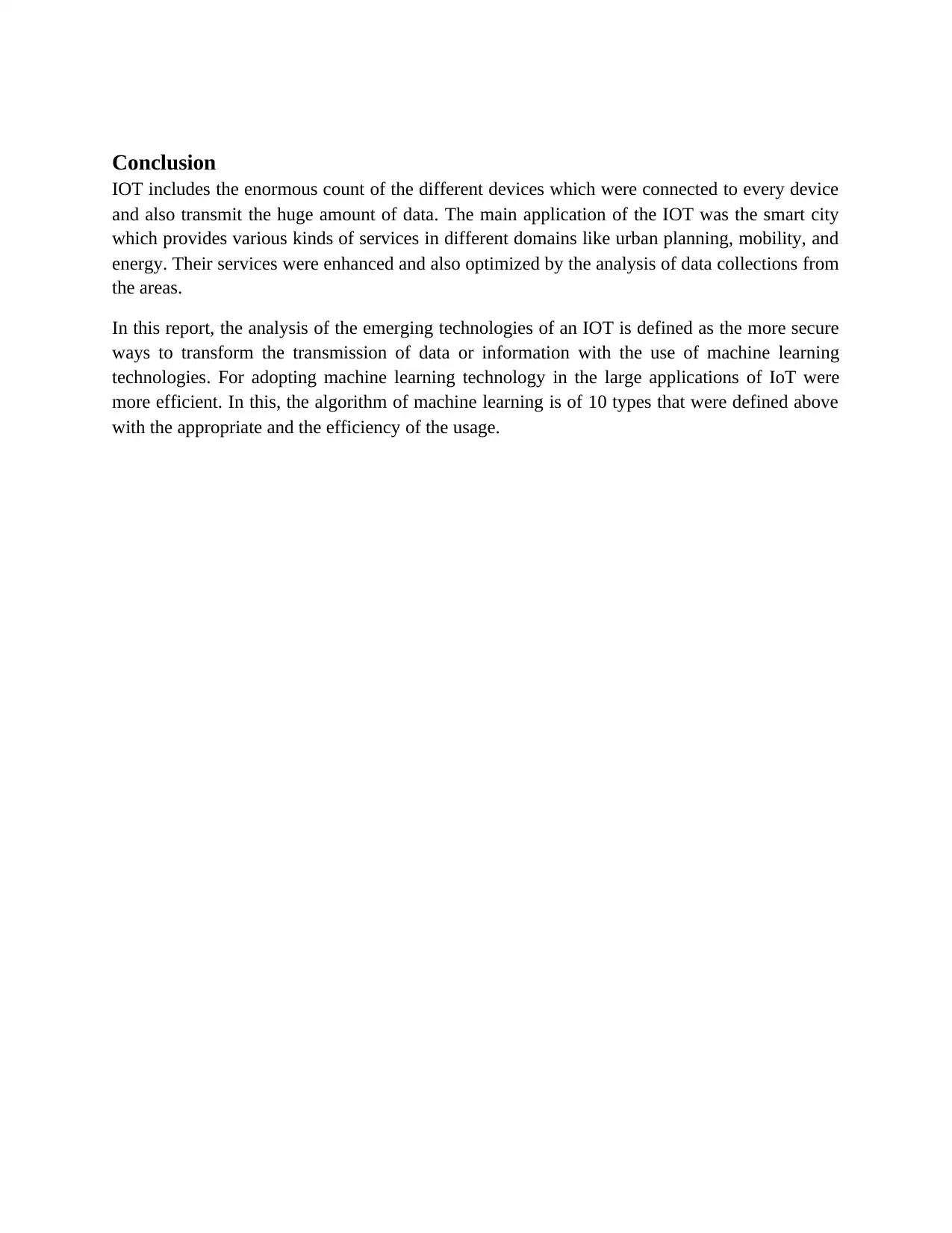
Conclusion
IOT includes the enormous count of the different devices which were connected to every device
and also transmit the huge amount of data. The main application of the IOT was the smart city
which provides various kinds of services in different domains like urban planning, mobility, and
energy. Their services were enhanced and also optimized by the analysis of data collections from
the areas.
In this report, the analysis of the emerging technologies of an IOT is defined as the more secure
ways to transform the transmission of data or information with the use of machine learning
technologies. For adopting machine learning technology in the large applications of IoT were
more efficient. In this, the algorithm of machine learning is of 10 types that were defined above
with the appropriate and the efficiency of the usage.
IOT includes the enormous count of the different devices which were connected to every device
and also transmit the huge amount of data. The main application of the IOT was the smart city
which provides various kinds of services in different domains like urban planning, mobility, and
energy. Their services were enhanced and also optimized by the analysis of data collections from
the areas.
In this report, the analysis of the emerging technologies of an IOT is defined as the more secure
ways to transform the transmission of data or information with the use of machine learning
technologies. For adopting machine learning technology in the large applications of IoT were
more efficient. In this, the algorithm of machine learning is of 10 types that were defined above
with the appropriate and the efficiency of the usage.
Paraphrase This Document
Need a fresh take? Get an instant paraphrase of this document with our AI Paraphraser
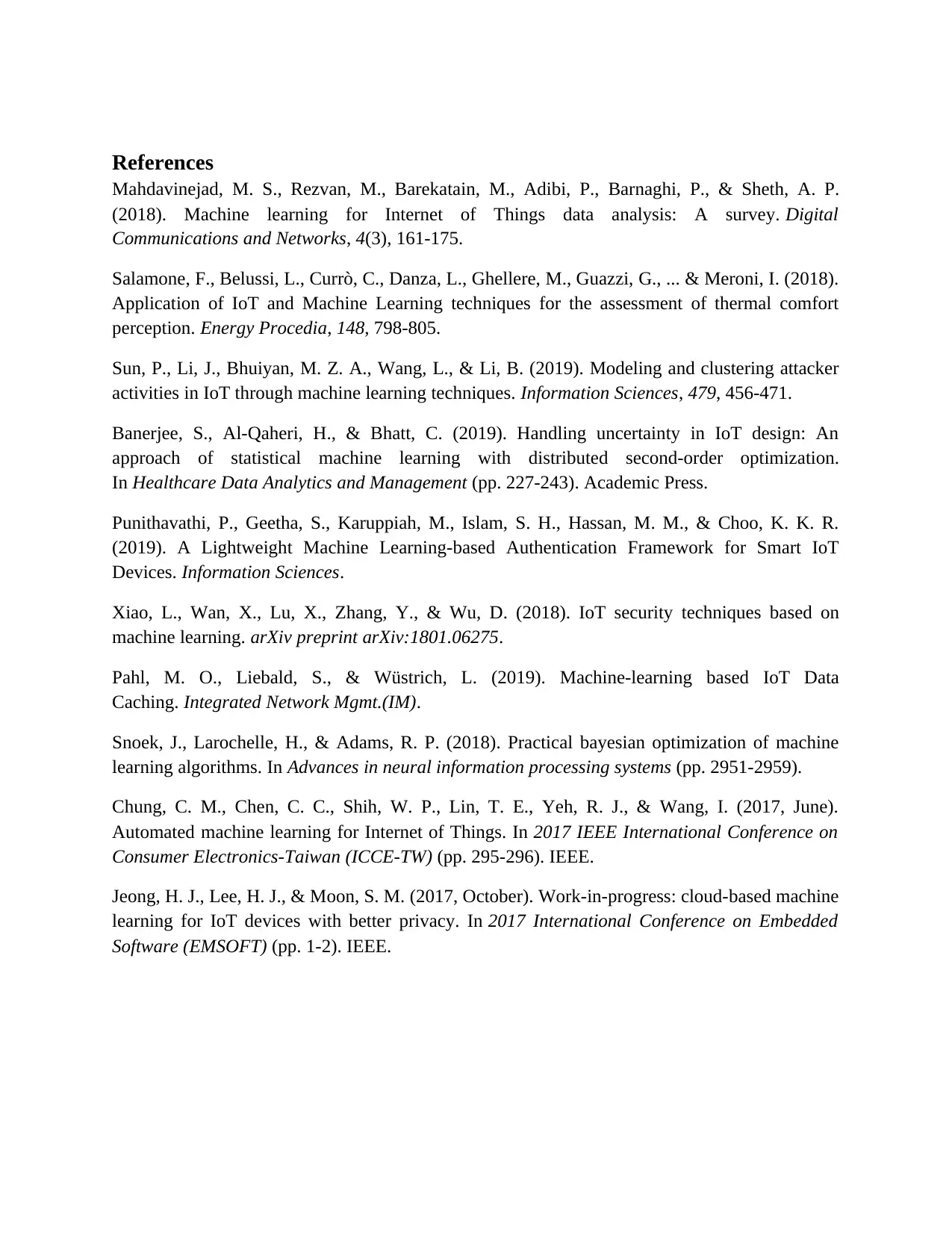
References
Mahdavinejad, M. S., Rezvan, M., Barekatain, M., Adibi, P., Barnaghi, P., & Sheth, A. P.
(2018). Machine learning for Internet of Things data analysis: A survey. Digital
Communications and Networks, 4(3), 161-175.
Salamone, F., Belussi, L., Currò, C., Danza, L., Ghellere, M., Guazzi, G., ... & Meroni, I. (2018).
Application of IoT and Machine Learning techniques for the assessment of thermal comfort
perception. Energy Procedia, 148, 798-805.
Sun, P., Li, J., Bhuiyan, M. Z. A., Wang, L., & Li, B. (2019). Modeling and clustering attacker
activities in IoT through machine learning techniques. Information Sciences, 479, 456-471.
Banerjee, S., Al-Qaheri, H., & Bhatt, C. (2019). Handling uncertainty in IoT design: An
approach of statistical machine learning with distributed second-order optimization.
In Healthcare Data Analytics and Management (pp. 227-243). Academic Press.
Punithavathi, P., Geetha, S., Karuppiah, M., Islam, S. H., Hassan, M. M., & Choo, K. K. R.
(2019). A Lightweight Machine Learning-based Authentication Framework for Smart IoT
Devices. Information Sciences.
Xiao, L., Wan, X., Lu, X., Zhang, Y., & Wu, D. (2018). IoT security techniques based on
machine learning. arXiv preprint arXiv:1801.06275.
Pahl, M. O., Liebald, S., & Wüstrich, L. (2019). Machine-learning based IoT Data
Caching. Integrated Network Mgmt.(IM).
Snoek, J., Larochelle, H., & Adams, R. P. (2018). Practical bayesian optimization of machine
learning algorithms. In Advances in neural information processing systems (pp. 2951-2959).
Chung, C. M., Chen, C. C., Shih, W. P., Lin, T. E., Yeh, R. J., & Wang, I. (2017, June).
Automated machine learning for Internet of Things. In 2017 IEEE International Conference on
Consumer Electronics-Taiwan (ICCE-TW) (pp. 295-296). IEEE.
Jeong, H. J., Lee, H. J., & Moon, S. M. (2017, October). Work-in-progress: cloud-based machine
learning for IoT devices with better privacy. In 2017 International Conference on Embedded
Software (EMSOFT) (pp. 1-2). IEEE.
Mahdavinejad, M. S., Rezvan, M., Barekatain, M., Adibi, P., Barnaghi, P., & Sheth, A. P.
(2018). Machine learning for Internet of Things data analysis: A survey. Digital
Communications and Networks, 4(3), 161-175.
Salamone, F., Belussi, L., Currò, C., Danza, L., Ghellere, M., Guazzi, G., ... & Meroni, I. (2018).
Application of IoT and Machine Learning techniques for the assessment of thermal comfort
perception. Energy Procedia, 148, 798-805.
Sun, P., Li, J., Bhuiyan, M. Z. A., Wang, L., & Li, B. (2019). Modeling and clustering attacker
activities in IoT through machine learning techniques. Information Sciences, 479, 456-471.
Banerjee, S., Al-Qaheri, H., & Bhatt, C. (2019). Handling uncertainty in IoT design: An
approach of statistical machine learning with distributed second-order optimization.
In Healthcare Data Analytics and Management (pp. 227-243). Academic Press.
Punithavathi, P., Geetha, S., Karuppiah, M., Islam, S. H., Hassan, M. M., & Choo, K. K. R.
(2019). A Lightweight Machine Learning-based Authentication Framework for Smart IoT
Devices. Information Sciences.
Xiao, L., Wan, X., Lu, X., Zhang, Y., & Wu, D. (2018). IoT security techniques based on
machine learning. arXiv preprint arXiv:1801.06275.
Pahl, M. O., Liebald, S., & Wüstrich, L. (2019). Machine-learning based IoT Data
Caching. Integrated Network Mgmt.(IM).
Snoek, J., Larochelle, H., & Adams, R. P. (2018). Practical bayesian optimization of machine
learning algorithms. In Advances in neural information processing systems (pp. 2951-2959).
Chung, C. M., Chen, C. C., Shih, W. P., Lin, T. E., Yeh, R. J., & Wang, I. (2017, June).
Automated machine learning for Internet of Things. In 2017 IEEE International Conference on
Consumer Electronics-Taiwan (ICCE-TW) (pp. 295-296). IEEE.
Jeong, H. J., Lee, H. J., & Moon, S. M. (2017, October). Work-in-progress: cloud-based machine
learning for IoT devices with better privacy. In 2017 International Conference on Embedded
Software (EMSOFT) (pp. 1-2). IEEE.
1 out of 8
Related Documents
Your All-in-One AI-Powered Toolkit for Academic Success.
+13062052269
info@desklib.com
Available 24*7 on WhatsApp / Email
![[object Object]](/_next/static/media/star-bottom.7253800d.svg)
Unlock your academic potential
© 2024 | Zucol Services PVT LTD | All rights reserved.





